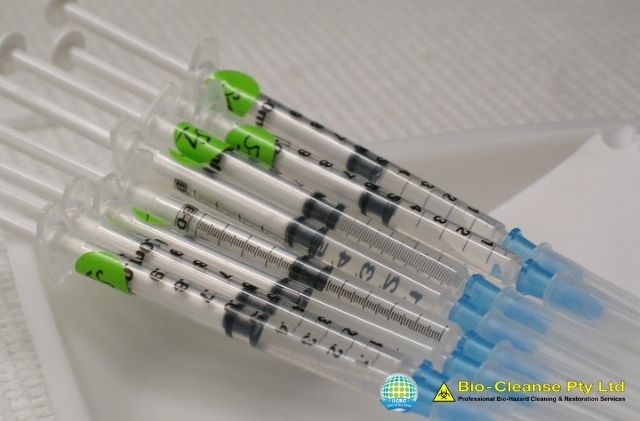
As a safety rule, sharps and needles should always be placed in approved waste containers immediately after use. If safe sharps disposal procedures are not followed, in private or public places, then these used sharps can be dangerous. Improperly disposed needles and other sharps can injure people and pets. There is a risk of infections spreading and causing serious health conditions.
For safe management of syringes, needles and other sharps waste and for Sharps and Needle Cleanup in Goulburn, Canberra, Batemans Bay and surrounding areas of NSW, you can rely on Biosite Cleanup.
What are sharps?
Sharps are medical devices with sharp points or edges that can puncture or cut skin. Some examples of sharps are needles, syringes, razor blades, lancets, scalpels, and other medical tools like auto- injectors, infusion sets and connection needles/sets.
Broken glass and glass contaminated with biohazardous and chemical material are also considered sharps. Sharps may be used to manage the medical conditions of people or their pets.
People may use sharps at home, at work and while travelling. They help to manage conditions like allergies, infertility, migraines, diabetes, arthritis, hepatitis, cancer, HIV/AIDS and many others.
Exposure to used sharps or needles may pose a health risk.
Sharps, syringes and needles can potentially be contaminated with blood, body fluid, infectious material or many different types of micro-organisms.
Exposure to these contaminants can occur after a needle stick or sharps injury, through the piercing of skin or contact with already broken skin.
Being exposed can also mean coming into contact with another person’s blood or body fluids from these medical devices.
Exposure poses a risk for transmission of certain infections. Infection from bloodborne viruses is well known. Diseases such as HIV, Hepatitis B and Hepatitis C could be transmitted through contaminated sharps and needle stick injuries. Workers can also be exposed to other infection risks such as Tetanus through skin-penetrating injuries. In veterinary practices workers may be exposed to animal diseases like Leptospirosis, Influenza and Q fever.
Preventing accidental injuries.
In any healthcare environment, sharps and needle stick injuries can happen. They are one of the most common worker’s compensation injuries that occur.
As far as possible, the risk of skin penetrating injuries caused by sharps should be eliminated or minimised. Organisations and persons in the business of using or handling sharps should implement a risk management process.
Injuries can also be avoided by wearing appropriate Personal Protective Equipment (PPE) for the designated task.
Safety controls for prevention of needle sticks injuries.
If safe workplace practices and controls are in place, sharps and needle sticks injuries can easily be prevented. These policies, procedures and environmental safeguards have to be put in place to protect both employees and visitors. Accidental needle stick injuries and cuts can be prevented by learning how to safely handle sharps.
Before using any sharp objects such as needles or scalpels, all other items like gauze, alcohol swabs and bandages should be kept ready and close by.
When required, use the protective devices provided like needle shields, sheaths, or blunting after removing the needle from the person.
Follow proper sharps disposal practices after use to ensure no harm or risk of infection.
- All organisations which use sharps must have an approved sharps waste container. Sharps disposal containers are yellow in colour, rigid and clearly labelled.
- The sharps disposal container should be placed in close proximity to the place of using the sharps.
- Ensure there is sufficient space in the container for the sharps being put in. A sharps disposal container should not be more than two-thirds full.
- Sharps should be placed in the sharps container immediately after use.
- Place the still-connected needle and syringe into the sharps container. Do not try to recap the needle.
- Sharps contaminated with biological, infectious material must be disposed in containers labelled accordingly.
- ‘Broken Glass Bin’ should have lids. Contaminated broken glass should be decontaminated before placing in the bin. When a ‘Broken Glass Bin’ is ¾ full, the bin should be sealed and placed in a ‘Red-lidded General Waste Bin’.
- Sharps containers designated for radioactive waste and sharps contaminated with radioactive material should be disposed of in accordance with the Radioactive Waste Guidelines.
- Only EPA-licensed waste disposal contractors should handle disposal of full sharps containers.
Also Read: Faq’s About Sharps and Proper Sharps Waste Disposal
Biosite Cleanup provides Sharps and Needle Cleanup services.
At Biosite Cleanup, the team of Sharps and Needle cleanup experts understand the dangers associated with the incorrect disposal of contaminated and used syringes and other sharps. Our trained and experienced professionals work methodically and systematically to ensure the area is left safe and biohazard free.
To speak to one of our technicians for Sharps and Needle cleanup, or to get information on any of our other services, you can reach us on 0409037634 or email us at bryan@biositecleanup.com.au.
